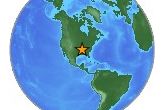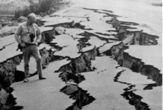Tennessee Quake Reminds of Region's Risk

MEMPHIS, Tenn. (AP) -- The temblor felt across northwest Tennessee on Thursday caused little damage, but it was strong enough to remind people they live in one of the country's most active earthquake zones.
The 4.0 quake on the New Madrid Fault system was centered about 10 miles northwest of Dyersburg near the town of Ridgely.
The New Madrid seismic zone produces close to 200 quakes a year. But most are around magnitude 2.0 and unnoticed by anyone but scientists.
Quakes of magnitude 4.0 are another matter.
People feel them and on average, such temblors occur once every 18 months or so in the New Madrid region. So far, there have been three this year, but that does not mean another one is likely soon or a bigger one is on the way.
"These earthquakes over longer periods of time tend to average out,'' said Mitch Withers of the Center for Earthquake Research and Information at the University of Memphis. "We could have several years where we don't see any magnitude fours and then all of a sudden we'll get a couple of them right in a row.''
In 1811 and 1812, the New Madrid fault system produced some of the strongest earthquakes ever to hit North America, with strengths estimated at what would now be measured as magnitude 8.0 or greater.
Get the world’s most fascinating discoveries delivered straight to your inbox.
The fault zone runs about 120 miles from northeastern Arkansas to southern Illinois. It is named for New Madrid, Mo., which sits along the main fault line.
The chances of a devastating New Madrid quake are slim, but for a damaging 6.0 temblor, "it's more a matter of when, not if,'' one will hit, Withers said.
The U.S. Geological Survey puts the probability of a magnitude 6.0 or greater quake in the New Madrid zone at 25 to 40 percent over the next 50 years.
Earthquake damage is caused by ground movement or shaking, and temblor strength increases 10 fold for each step up in a whole number on magnitude scales. A 6.0 quake is 10 times stronger than a 5.0 and 100 times stronger than a 4.0.
A 6.0 quake could cause widespread property damage, depending where along the fault system it occurred. Memphis is 50 miles from the fault, and is the largest city closest to it.
Withers said quakes measuring just over 4.0 occurred in the area of Blytheville, Ark., last month and in February. No major damage was reported.
James Paul Medling, Dyer County fire chief, said the West Tennessee quake set off a flurry of phone calls from worried residents.
"I was still in bed,'' Medling said. "I felt my house shake twice, my bed shook twice and I heard a big boom.''
He said he went outside and the water was swirling in his dog's water bucket.
A series a seismic sensors covers the New Madrid region, and the 4.0 temblors will help scientists study of the fault zone.
"What we don't have a lot of data from are the mid and large earthquakes,'' Withers said. "It will help us reduce the error estimates on what the earthquake hazards are, the type of ground shaking that will be experienced.''
Central US Warned of Larger Earthquakes to Come
Only in California: Daily Earthquake Forecasts
Earth Puts Big Squeeze on Los Angeles
Ominous Rumbling Under San Andreas Fault
Seismologists Target Better Earthquake Prediction
Quake Death Toll in 2004 Could Be Worst Since 1556
Earthquakes Stopped, But Only In Lab
Image Gallery
Deadly Earthquakes
Top 10 U.S. Quakes
Live Science / SOURCE: USGS



